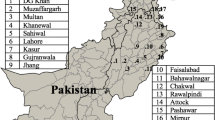Abstract
Most of the topsoils encountered in United Arab Emirates and in the Arabian Peninsula are granular soils with small percentages of silt and clay. Determination of the compaction characteristics of such soils is an essential task in preparing for construction work. The accumulating experience over many years of soil testing in our laboratories suggested that there exists an underlying trend that governs the compaction characteristics of such soils. As such, a study was undertaken to assess the compaction characteristics of such soils and to develop the governing predictive equations. For the purposes of this study, 311 soil samples were collected from various locations in the United Arab Emirates, and tested for various including grain-size distribution, liquid limit, plasticity index, specific gravity of soil solids, maximum dry density of compaction, and optimum moisture content following ASTM D 1557-91 standard procedure C. Following the development of the predictive equations, a new set of 43 soil samples were collected and their compaction results were used to test the validity of predictive model. The range of variables for these soils were as follows: percent retained on US sieve #4 (R#4): 0–68; Percent passing US sieve #200 (P#200): 1–26; Liquid limit: 0–56; Plasticity index: 0–28; Specific gravity of soil solids: 2.55–2.8.
Based on the compaction tests results, multiple regression analyses were conducted to develop mathematical models and nomographic solutions to predict the compaction properties of soils. The results indicated that the nomographs could predict well the maximum dry density within ±5% confidence interval and the optimum moisture content within ±3%.
Similar content being viewed by others
References
American Society of Testing and Materials (1998) Annual Book of ASTM Standards, 04.08, Conshohocken, PA.
Johnson, A. W. and Sallberg, J. R. (1960) ‘Factors That Influence Compaction of Soils,’ Bulletin No. 272, Highway Research Board, National Academy of Sciences, Washington, D.C.
Kofiatis, G. P. and Manikopoulos, C. N. (1982) ‘Correction of Maximum Dry Density and Grain Size,’ Journal of Geotechnical Engineering Division, ASCE, Vol. 108 No. GT9, 1171–1176.
Ring, G. W., Sallberg, J. R. and Collins, W. H. (1961) ‘Correlation of Compaction and Classification Test Data’, Bulletin 325, Highway Research Board, pp. 55–75.
'Soil Compaction Report No. 4, (1949) Compaction Studies on Sand Subgrade,’ Tech. Memo 3–271, U.S. Corps of Engineers, U.S. Waterways Experimental Station, Oct.
Winterkkorn, H. F. (1967) ‘Application of Granulometric Principles for Optimization of Strength and Permeability of Granular Drainage Structures,’ Highway Research Record, Vol. 55 No. 203, pp. 1–7.
Author information
Authors and Affiliations
Rights and permissions
About this article
Cite this article
Omar, M., Shanableh, A., Basma, A. et al. Compaction characteristics of granular soils in United Arab Emirates. Geotechnical and Geological Engineering 21, 283–295 (2003). https://doi.org/10.1023/A:1024927719730
Issue Date:
DOI: https://doi.org/10.1023/A:1024927719730




